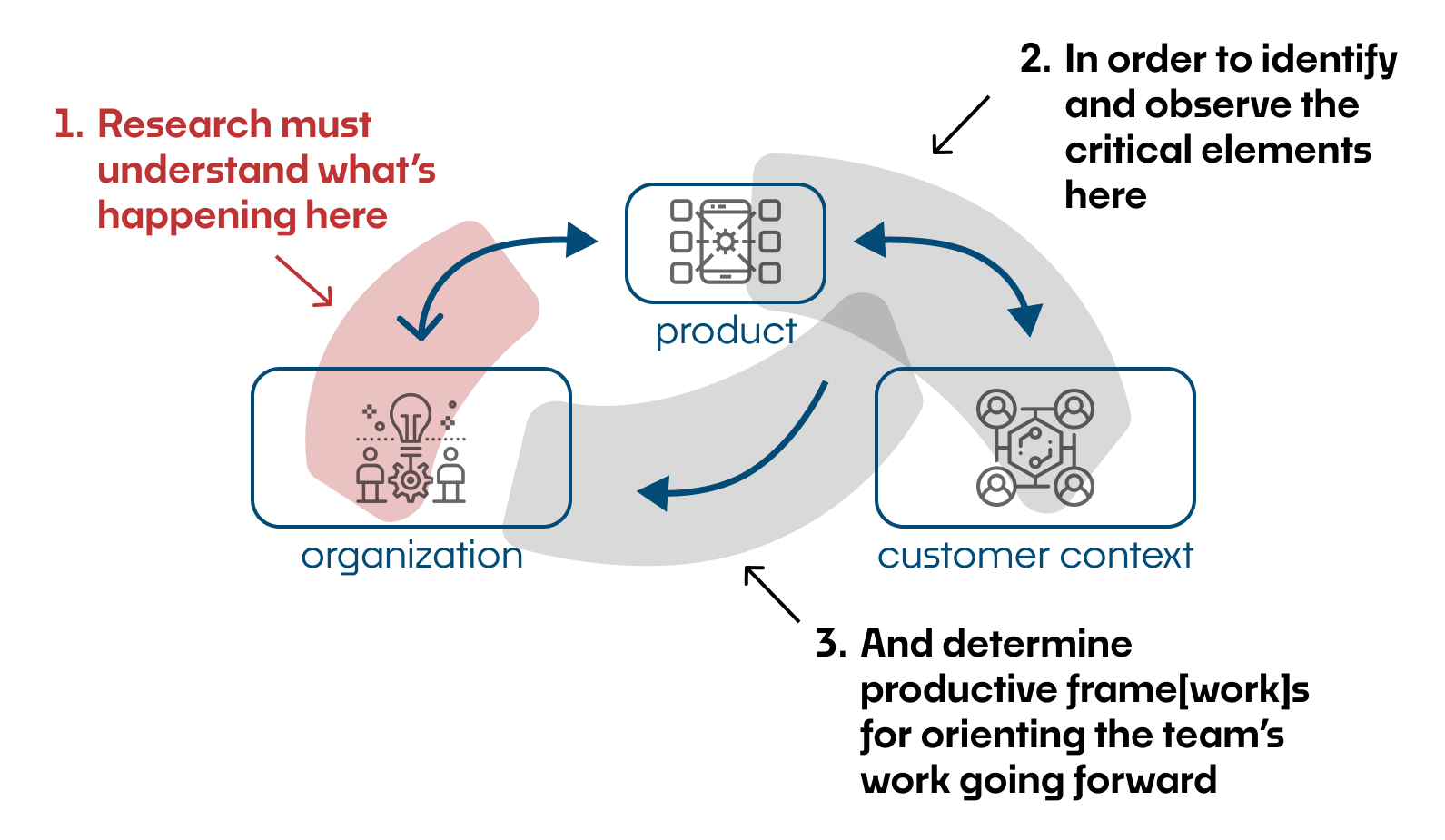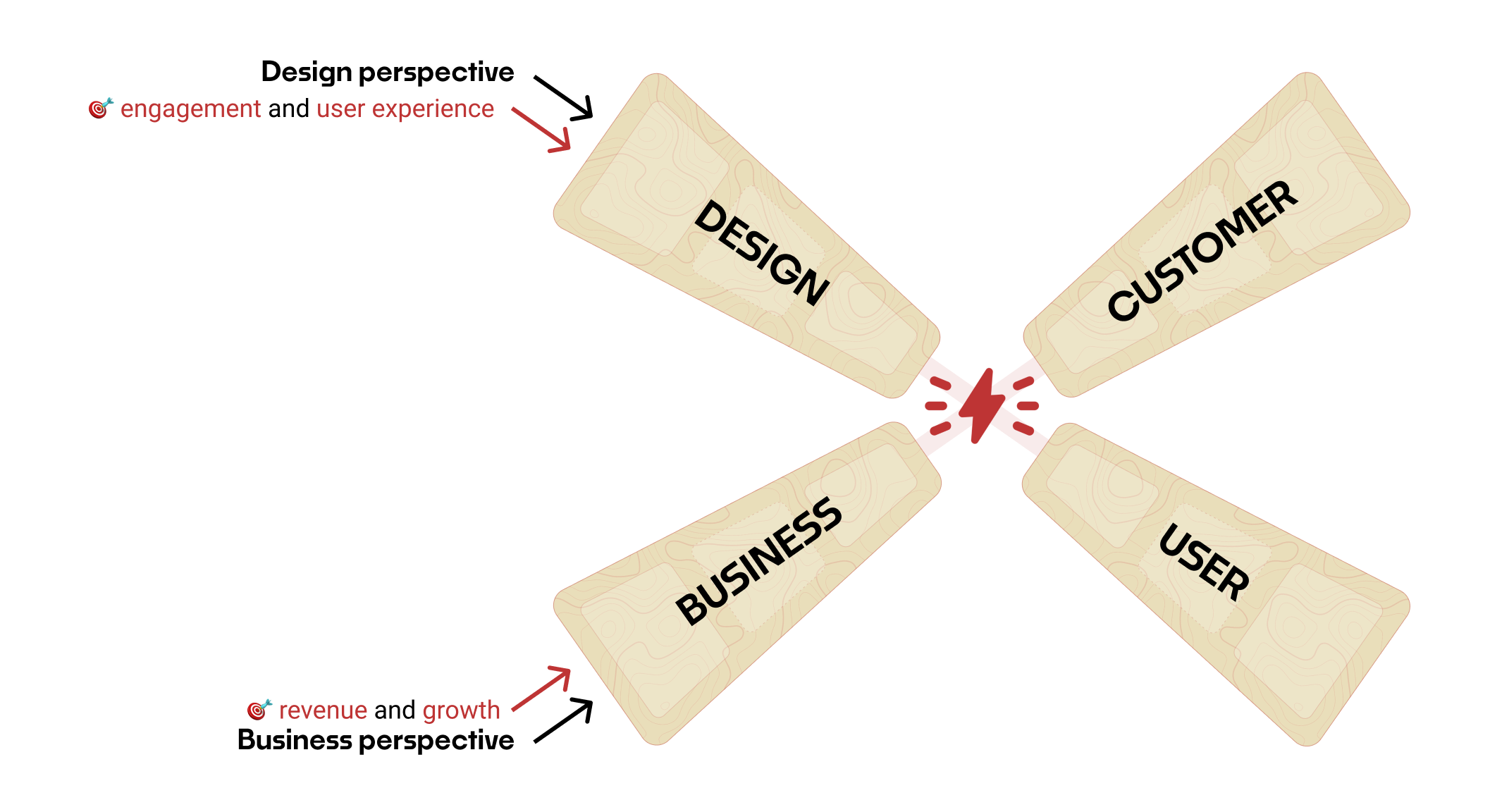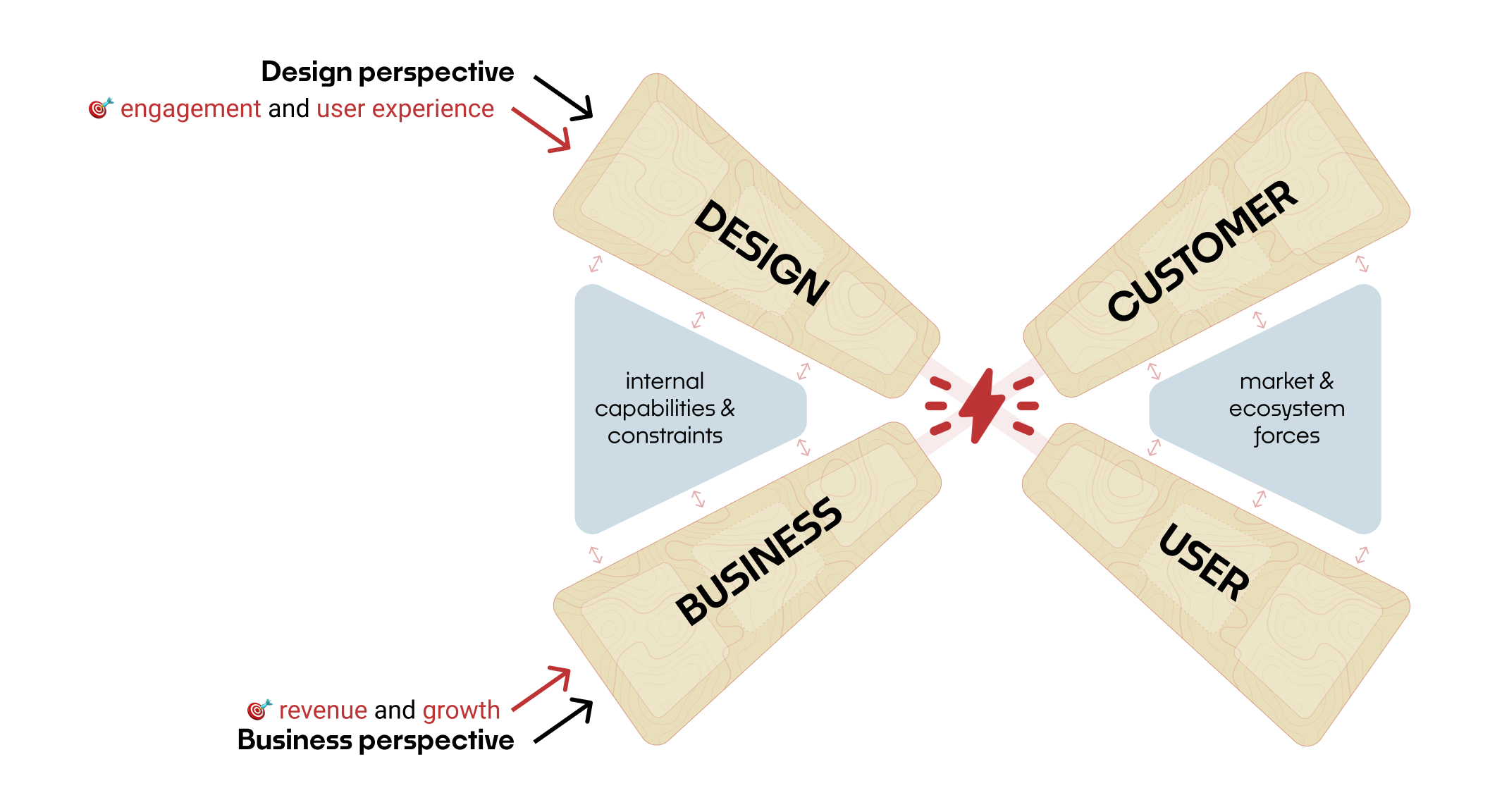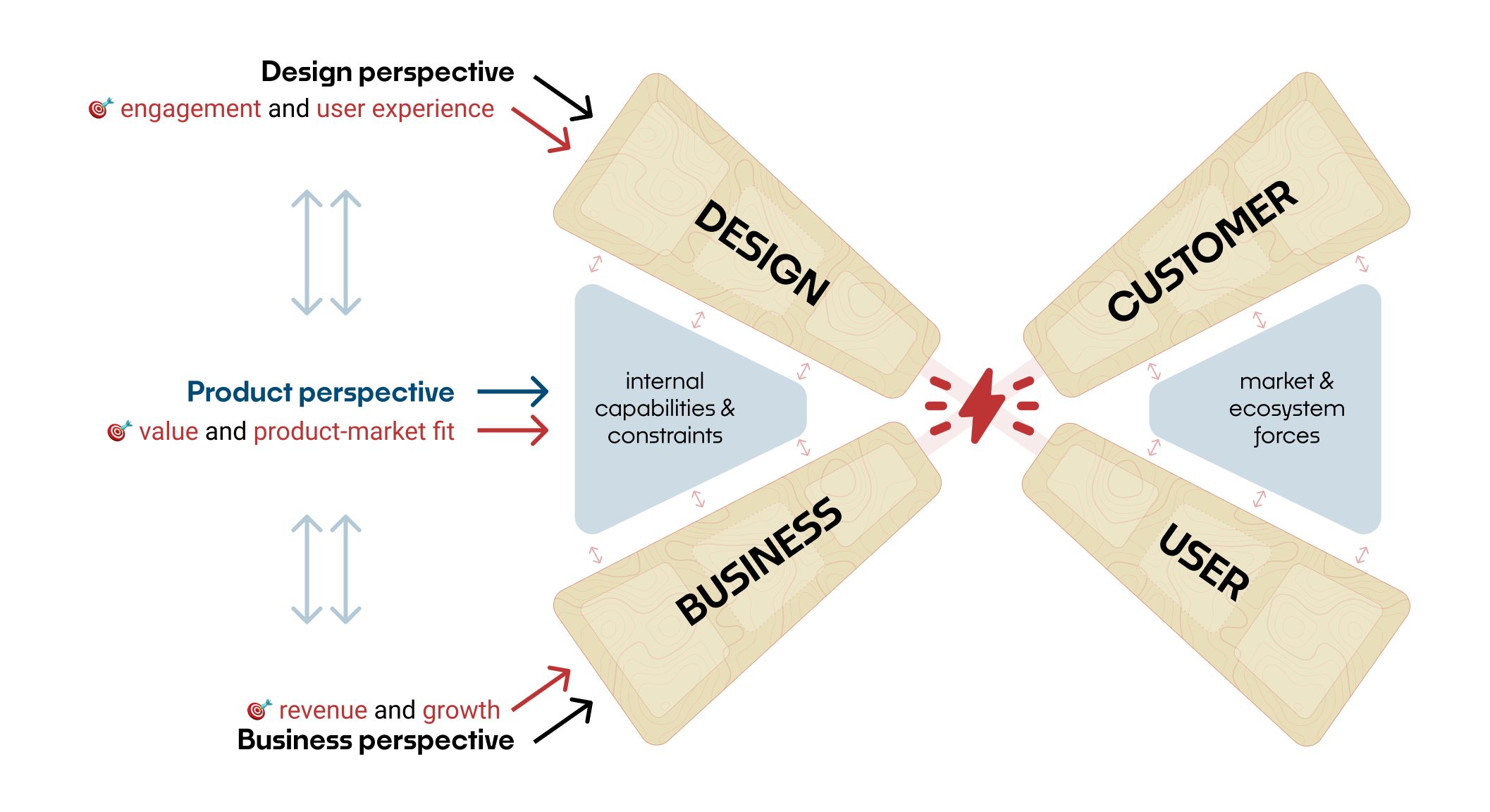In July, 2015 I was working as the first researcher at Instacart when Max, one of the founders, asked if I'd like to go to a "Designer Dim Sum" with John Maeda. (Yes! Yes, obviously. And thank you.) As our group walked out of dim sum brunch, I asked John about continuing education: to keep growing, should I return to school for a master's degree in design? I only had an undergraduate degree in cognitive science and human-computer interaction.
John said to me "Don't worry about design school. You already get it. If you want to grow your career, get a good MBA. Right now, you smell funny to business people. With a good MBA, you will smell all right to the business people."
I did not, for better or worse, take on any further education in design or business. But the seed John planted began growing immediately: why do I need to get in with "the business people" — and what the hell does he mean, smell funny?
Research begins by understanding internal perspectives
Consider research as a sensing mechanism that enables the team to respond effectively to external context — that may mean acting on hidden opportunity, mitigating risk and avoiding failure, or just creating, packaging, and shipping better product.
Last week in Where UX Research Is Working, I said that researchers are trained to observe the customer context and feed that back into the organization to support the team. But that's not the starting point. Because what we need to observe and how it's fed back into the organization, to be productive, is dictated by the current, specific situations the team and the organization are facing.

Rather than beginning with the outside context, good work must begin by understanding the internal context of the organization.
And as we work with any situation inside the organization, we inevitably confront the truth of the Design versus Business divide that John referred to at dim sum brunch — different people, working in the same place, can have completely different perspectives regarding what’s happening and which aspects are critically important. The degree of difference is always in motion, within and across organizations, but that difference between Business and Design is quite real.
Here, we'll try to profile three different views of "what's going on" inside the organization — Design, Business, and the Product perspective that attempts to balance those two.
How Design sees
From the Design perspective, there's an "us" on the organizational side, and an unknown but not-unknowable "them" on the user side that we serve.

When the two sides are in balance and coupled — when the capabilities we implement address real user needs in a meaningful sense — we expect engagement. When the pathways and processes by which users interact with our work are simple, sensible, and snap into how those users see the world, we expect a qualitatively good user experience to emerge, and real, meaningful engagement to follow.
With a Design mindset, we talk about user workflows and needs and pain points. We work with concepts, make prototypes, model user scenarios, implement experiments, usability test them, A/B test them, study performance in the field, and instrument quantitative measures to understand the performance of what we're building. We speak about crafting experiences, and this is a clear indicator of where our humane and humanistic values tend to lie. We see ourselves as accountable to the user, and when their needs overlap, the customer, too.
For many readers here, and a majority of those working in the world of research, the Design perspective acts as an unexamined default. However, (as John pointed out) it's certainly not the only one, and it's rarely the main driver of organizational activity.
How Business sees
That primary driver of organizational activity is what we'll call the Business perspective. It's the unexamined default perspective of MBAs everywhere. And it's more-or-less invisible to those trained for a design-oriented profession unless they chase down inevitable organizational tradeoffs — "hold on, why did we end up [making that choice]?" — or actively start attending to and deciphering the financial reports and plans presented at the company all-hands meetings.
From the Business perspective, there's also an "us", on the organizational side, and an unknown but not-unknowable "them" on the customer side that we serve.

When the two sides balance and couple, we create revenue. As we work to build and evolve the business over time — remember, the market moves and nobody else is staying still — we must have revenue, but we must also have growth in our revenue and other key indicators.
With a Business mindset, we talk about customer lifetime values and sales cycles and cashflow and margins hiring plans and revenue plans. We measure performance week over week, month over month, and year over year. With discipline, we take very little for granted. Everything has a cost and an effect on the bottom line. Incentives and accountability are radically different, here: we answer to our investors, the board, and public markets. Like the Design perspective, we believe in the value of a culture that allows for strong and healthy teams, adaptation to changing conditions, and innovation.
While the terms and ideas may be familiar to many from the Design perspective, very few from this other camp — until, perhaps, a successful climb into management — can work from the Business perspective as a primary lens for understanding the work going on in the organization and assessing its worth. (When I first encountered it, I found Jared Spool’s talk “UX Strategy Means Business” [transcript, video] a great first approach towards this seemingly-separate perspective.)
Design and Business intersect
These two perspectives are insulated from one another, but not isolated. In the world of modern software organizations, as evidenced by the rise of Design and UX professions over the last 20 years, both perspectives are required for the organization to survive, grow, and adapt.

What will differ, from organization to organization, is the angle at which Design and Business sit (you never want to go full orthogonal!), and the relative primacy that one perspective has over the other, a pendulum that will swing as the external market and internal product reality co-evolve.
The further apart these perspectives sit, the more the Design and UX and Research teams will grapple with the question of ROI. This is especially true when when Design is poorly understood or, for example, the customer market is in a commodity space that does not differentiate on design.
And all B2B organizations will grapple with the User/Customer divide. I first encountered this idea diagrammatically in Majid Iqbal's Thinking in Services, with separate kinds of outcomes and activities pertaining to Users vs. Customers. I then encountered it practically at PlanGrid as our land-and-expand (user-driven) sales strategy moved upstream to (customer-driven) corporate accounts. Especially in large enterprises and government, those who buy and those who use may have completely different views on what is needed, or useful. Design and Business need to negotiate the tradeoffs.
Concrete realities create compromise
Even so, for any successful organization, the inescapable reality of internal constraints and external forces will squeeze the two perspectives together into a coherent response.

Internally, on the "us" side, Design and Business are drawn together by the realities of implementation capability, contractual customer agreements, past strategic decisions, and technical debt. Externally, on the "them" side, Design and Business must mutually respond to ecosystem trends, technological evolution, legal and regulatory forces, and competitive pressure.
With this additional dose of concrete reality, three areas must balance out:
- The Design drive to serve the user and deliver on user experience,
- The Business need to serve the customer and grow revenue,
- The internal constraints and external forces acting on an organization inside an evolving competitive ecosystem.
Product on the Design↔Business spectrum
In these sketches, rather than specific and well-defined points of view, we should look at Business and Design as end-poles on a spectrum of organizational awareness.
Product takes up a position somewhere in between the two: neither Design nor Business should reign absolute. Both have valid and essential sensibilities required to engage in the current world of software work that we (a very broad, historical, and capital-oriented we) have constructed for ourselves.

If Design is concerned with what gets implemented for the user and how it works, and Business is focused on what is offered to the customer and how it's packaged and sold, Product grinds these perspectives together in the mill of reality: the capabilities, constraints, and forces that neither side of the organization can afford to ignore.
Someone has to make sure we turn tensions and trade-offs into specific choices and maintain a coherent effort to bring our ideas to bear and get them into the market. For our rough sketch purposes today, this is the Product perspective's integrative wheelhouse.
My claim is that, if we view Design and Business as opposing ends of a spectrum of views, most of the functions at play in a modern software organization have a point of view that can be located somewhere along this axis of perspective, from Business ↔ Product ↔ Design, and we'll sketch this out down the road. (If the spectrum holds, it should mean that the overall tenor and orientation of the organization can be uncovered by examining recent-past Product decisions and how they were made.)
Looking forward: integrating with the Product perspective
The majority of us (researchers, insights folks, UX people, designers) implicitly take the Design perspective without strongly considering or even attempting to understand the Business perspective. If you hear ARR, LTV, CAC, or QBR, and think "That stuff is for the business people, and they smell funny", I'm also talking about you.
I believe Product's perspective offers a strong middle ground between Design and Business and an exciting place to play for research going forward. It has, at the least, the same urgency for well-informed decisions as the Design perspective, though it may need "research-grade" awareness at a lower frequency. There's no easy answer here, no solution to the squeeze the research profession is feeling in this time of economic efficiency — everything evolves, and our market is moving, too.
Regardless, our path forward is to find the leverage that tightly integrates our work into the organization. That begins with seeing the full spectrum of perspectives for ourselves, understanding where "the other side" (the funny-smelling side) is coming from
We'll build on these ideas, take a more detailed look at other functions in the organization, and explore what it means to align our work with other perspectives in coming editions.
This essay is part of my larger exploration into the evolution of research and its integration with product practices in the organization.
For behind-the-scenes updates, contextual commentary, and personal prognostication, try my newsletter.



